|
|
 |
| Volume VII, Number 2 |
A review of Peugeot 206 in miniature.
|
When
Peugeot presented the 206 in 1998, it was a big challenge for the marque.
This car
has to continue the success of the famous 205, which saved Peugeot
in the 1980ís and 1990ís. Now, we can say that the 206 is
a success too: since 2002, this is the best seller car in Europe, and this
is the first time that Volkswagen Golf isn't since 20 years. The
Peugeot 206 exists in many bodies: the first one is the sedan 5 doors. Just
after that came the 3 doors version. At the 2000 Paris motor show, Peugeot
shown a concept car called heart (vainqueur in French, untranslatable
puns on the pronunciation, which means victorious), which announced a convertible
version of 206. It was finally released in 2001, and called 206 CC. This
version has the particularity to have a hard roof, which can retract itself
in the boot, just like the Mercedes SLK. This was the first time that such
a small car proposed this type of roof. The last version, the estate, was
released in 2002, and is called SW (which stands for Station Wagon). The
206 is also a great competitor in the World Rally Championship. The 206 won
the 2000, 2001 and 2002 championship, and finished second of the
2003 championship. Such a success of the real car makes it of big interest for diecast manufacturers. Many of them have done it, and I'm at the moment trying to have at least one of each. The only body version that hasn't been reproduced is the estate; I hope that a manufacturer will do it in the future Let's do a review of these models: The 5 doors model: for now, only Welly has done it. This model hasn't got any moving part |
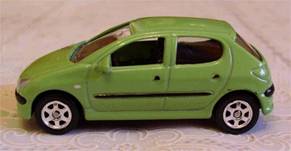 Welly Peugeot 206 5 doors |
The 3 doors model: Majorette was the first to produce one. Norev has done it later. Both models have moving parts: the Majorette has an opening motor hood, and the Norev has an opening rear hood. Note also the wheels of the Norev: as all the new Norev models, they are exact, and reproduce the aluminum wheels found on the sport version 206 S16.
 |
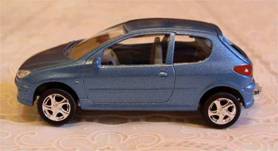 |
| Majorette Peugeot 206 3 doors | Norev Peugeot 206 3 doors |
The convertible/coupe model: 3 manufacturers have done it: Welly, Norev and Majorette. Only Norev provides a removable roof, and exact wheels. The Majorette has tampos instead of clear headlights, like all the new Majorette models. It's fun to see that all these models were first available in silver (which was the color of the motor show prototype).
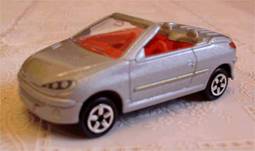 |
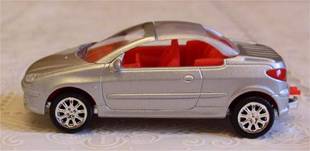 |
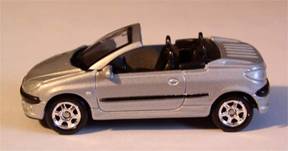 |
| Majorette Peugeot 206 CC | Norev Peugeot 206 CC | Welly Peugeot 206 CC |
The WRC model: this one is probably the most done in miniature. Norev, Majorette, Guisval, Real Toy and Track Stars have done it. Note that Track Stars use the Real Toy casting, but provide a model with roll cage. Also, Norev has done 2 versions of the car: the 2001 and 2003 versions, which have different rear wings and motor hood, and obviously different painting schemes. Both cars have a roll cage. Norev provides 2001 and 2003 painting, Majorette 2002 and 2003 painting (the car is a 2002 evolution). Majorette 206 WRC don't have an interior, like many Maisto models, and don't have clear headlights, just like the 206 CC. Guisval provides the 1999 Tour de Corse version (which was the very first race of the car); the 2001 painting, and a Havoline painting that I don't know if it matches a real car. RealToy provides the car in simple colors, such as white, yellow, red and blue. Track Stars provides it with racing generic paintings.
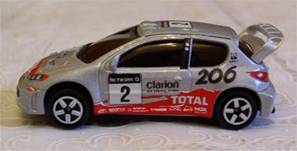
|
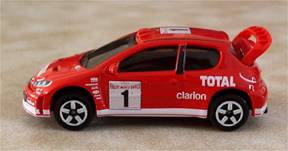
|
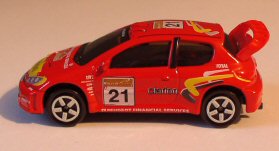
|
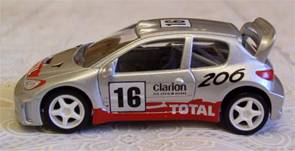 |
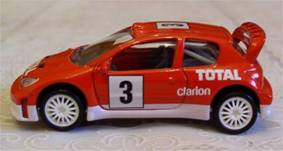 |
| Norev Peugeot 206 WRC (2001 painting and body). This car is sold with #1 by Peugeot, #16 by Norev, and #2 by Club Total (as promotional toy). | Norev Peugeot 206 WRC (2003 painting and body). The car is sold with #1 by Peugeot, and #3 by Norev and Club Total. |
| Note also the different wheels between the 2 versions, they are accurate. But both cars have the same problem with rear wing: it is by far too vertical. | |
 |
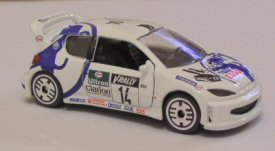 |
| Guisval Peugeot 206 WRC. This is the painting for the very first race of the 206 WRC: "Tour de Corse 1999". This is the car of Francois Delecour. It matches quite perfectly the real car. This paint scheme is unique in miniature, and very interesting (and as I love particularly this one, I've put 2 photos of it ;) ). | |
This car has opening doors, but the wheels are really ugly. Just imagine what this model could be with exact wheels, like the Norev ones! | |
 |
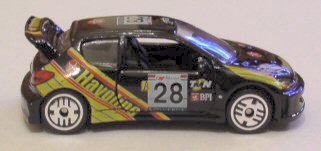 |
| Guisval Peugeot 206 WRC (2001 painting). | Guisval Peugeot 206 WRC (Havoline painting, I don't know if this model exists really). |
| If I'm right, there is a fourth painting available: silver background, with blue and red. This should be the car of Miguel Campos. But I haven't saw it yet, so I'm not sure. | |
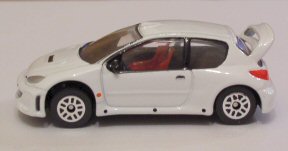 |
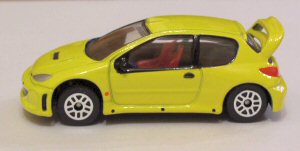 |
| Realtoy Peugeot 206 WRC in white. | Realtoy Peugeot 206 WRC in yellow. |
| This model is highly detailed, with nice painting. The body featured is
2001. But it doesn't have clear headlights, they are painted. The interior
is also very well detailed, with the racing touch, red racing seats. Really
nice! Under the marque Realtoy, this model also exists in red and in blue. This model is also distributed by Polistil and by TRU marque Fast Lane. | |
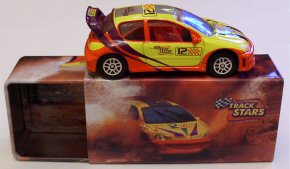 |
 |
| Track Stars Rallye Peugeot 206 WRC. | Track Stars Rallye Peugeot 206 WRC. |
| These models use the Realtoy casting, with the major difference that they have a roll cage. The painting seems to be pure fantasy. They come with a very nice metal tin, which is painted using the theme of the car: The yellow/red one is a mud car, and the silver/blue one is a sand car. | |
With these models end this review. I've tried to be exhaustive to the maximum, but I may not be aware of all painting variations, and maybe there are some other castings. If you know more about Peugeot 206 in miniatures, don't hesitate to contact me, I'm always looking for them ;)
Francois Rivierre (MCCH: FRiviR4. contact: FRiviR4@ifrance.com)
|
HOME>>
|
|


